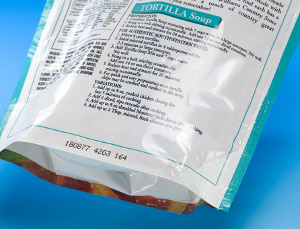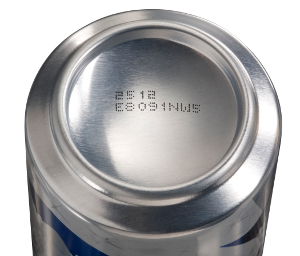
The rapid growth of global trade has brought about a greater need for tracing systems that accurately and efficiently identify and track a product or component, not just from manufacturer to initial customer, but throughout its entire value-add lifecycle. Successful traceability relies on the application of readable, high-quality codes that will endure a variety of conditions and environments and that emphasize the critical role of marking and coding technology in this process.
When it comes to purchasing new coding equipment, the focus is often on identifying the right printer. An error in printer selection can cause disruptions and waste on the plant floor, impacting both production line efficiency and the bottom line. Equally, and sometimes even more critical but often overlooked, is selecting the right ink.
On the surface, ink selection at first may seem straightforward. For instance, manufacturers generally understand that the material being coded influences ink selection. Paper products can typically accommodate most ink types but new plastic formulations that present more complex challenges to ink code adhesion are constantly being developed.
Also, not all inks adhere equally well in every condition. Factors like moisture, temperature and humidity can all impact ink code durability. Drying and curing times are also crucial to a code's survival in a manufacturing environment. Other factors may influence an ink's performance including the timing of the printed code's first contact with a human or mechanical handling device like a belt or roller; the type and pressure caused by handling devices; and a printed code's proximity to another product.

Substrate and manufacturing process conditions such as elevated temperature or product-roller pressure can induce code transfer, and should be considered when choosing an ink.
In addition to these considerations, there are several other important factors that manufacturers themselves may overlook. All can have a lasting impact on a code's integrity.
1. Practice cradle-to-grave coding
One of the most common pitfalls in ink selection is not evaluating the full range of conditions that a product will endure throughout its entire lifecycle. While a manufacturer may conduct a full assessment of the ink code performance through every step of the manufacturing process, it is just as important to look at what happens once the product leaves the plant.
Even a seemingly simple product such as a soft drink has lifecycle considerations after it leaves the bottling plant. Will it be tossed in a cooler or ice chest? By thinking about the life-cycle environment, manufacturers can properly work with their ink suppliers to make sure they get a code that best matches their and their customers' expectations for code quality and durability.
2. Take a holistic approach to product testing
In-house validation testing is critical to making sure that the best ink is qualified and selected. Most manufacturers will conduct their own tests applicable to their own familiar production process. But there's more that can be done so the testing and validation process better replicates the lifecycle conditions to which the ink code will be subjected. By partnering with the ink and printer manufacturer, the list of potential inks can be narrowed to a more defined set and critical validation tests can be identified.
The best printer/ink suppliers are skilled in probing for the right questions. A thoughtful discussion and test plan often results in defining the right criteria. This often then leads to product manufacturers bringing their customer into the evaluation process. The result the development of a robust test plan that spans from actual sample printing through to validating ink performance. The tests help in avoiding surprises that can occur long after the product leaves the manufacturing facility. Further quality tests by the customer should also be conducted in their actual production environment.
By involving all parties in the testing process, manufacturers can more easily diagnose and anticipate potential issues before they even occur and develop solutions before their printed codes fail to meet the customer's needs.
3. Ask the experts
Manufacturers should take full advantage of the ink expertise offered by their marking and coding ink and equipment partner. There are multiple options and considerations to take into account when choosing ink, but by engaging ink and printer application specialists and chemists, manufacturers can achieve a greater understanding of their specific needs.
Ink specialists can help to quickly narrow the selection from over 100 possibilities to as few as one or two potential inks to be more closely scrutinized in the final ink selection process. Ink suppliers can also help troubleshoot new problems that may arise years after initial implementation. Perhaps an ink that worked yesterday doesn't work today due to a subtle change in a manufacturing process or an undisclosed change made by a substrate or parts supplier.
For instance, a flexible film producer might develop a product that has the same appearance as their previous film, but that for reasons of "improved" film function or durability, now results in a small change in the surface chemistry that impacts ink code adhesion and durability. An ink specialist can help diagnose these problems and recommend solutions that get the manufacturer back to optimal coding performance.
4. Stay on top of new technology
Just as manufacturers are always changing and improving their processes, ink specialists are constantly researching new formulations to meet new coding application challenges. Manufacturers need to take this into consideration as they upgrade or expand their systems.
If a manufacturer plans to add a second production line, they may think about simply replicating the same coding and marking solutions from the first line. However, they need to ask themselves, has a better ink solution been developed in the time since I installed my first production line? Can a more durable or more visually attractive ink strengthen my brand? There is a good chance the answer will be "yes" as the best ink a year or two ago may have already been improved.
5. Resist the temptation to cut corners
Printer design engineers and ink specialists work together to design the printer and supporting fluids so they work hand-in-hand. This involves concurrently developing inks and designing printers as a matched set. Remove one part of that equation and the system may not run as efficiently. Some manufacturers may be tempted to save money by purchasing fluids from a third party ink supplier, but since they are not necessarily engineered to match exacting printer specifications, these products can degrade a printer's performance and code appearance over time. As a result, the purchase of non-brand supplies can likely cost much more in the long run due increased costs associated with excessive maintenance, premature part failures and unpredicted downtime.
6. See the complete picture
Maintaining a code's integrity throughout the lifecycle of a product or component is critical to achieving full product traceability. Without the right ink, the likelihood of a code meeting this goal drops significantly. By educating themselves about their customers' needs and consulting with ink and printer application specialists, manufacturers can get a complete picture of a code's endurance so they can choose the best code for the job.
THE MANY APPLICATIONS OF CODES
Codes enable information to be communicated in an accurate, consistent and expedient manner. Some real-world examples of code uses are:
Factory Automation: Capture information to guide and expedite an automated process. For instance, a tray of meat can be coded with date/time, weight, batch number and destination for efficient processing.
Color Coding: Color code parts to help ease the assembly process. Codes can be alphanumeric while instructional symbols can illustrate which direction a product should be installed or used.?
Grading: Communicate product quality compliance. This is helpful in the automotive, electrical industry and others where different grades impact a part's authorized installation location.
Branding and Promotion: Communicate company name and promote brand recognition by printing directly on products without traditional outer graphical packaging, such as pipes and building materials.
Traceability: Efficiently trace products to limit product liability and make potential recalls faster and narrowly targeted. This is critical in many industries, but especially food and pharmaceutical.
Regulatory Compliance: Print codes or regulatory symbols on products or packaging, to specify adherence to government regulations..





